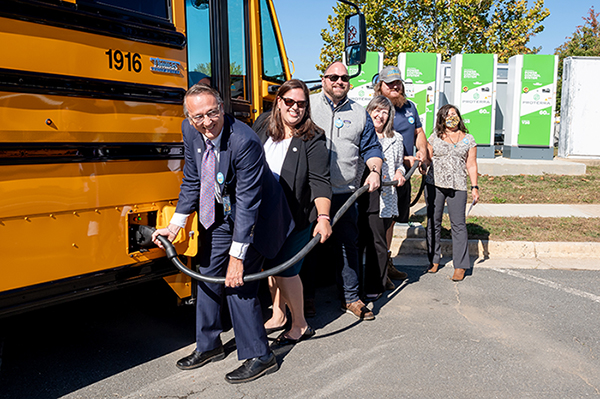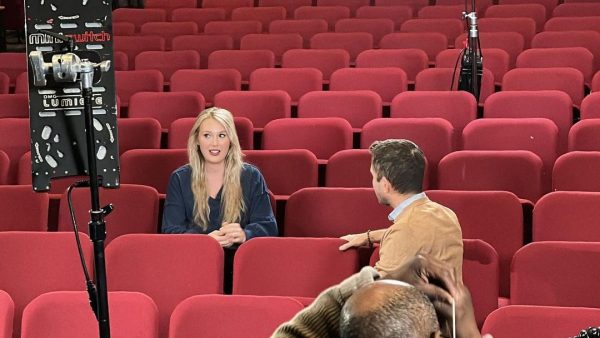Is AHS preparing students for the 21st century?
Grades on your phone, textbooks and classes online, laptops provided by the school, these are all relevant changes in technology AHS has worked to incorporate into education. But how effectively are teachers utilizing the technologies at their fingertips? And is AHS adequately preparing students for the 21st century?
AHS has made attempts to synchronize teaching with technology by incorporating more technologies into the classroom, like online textbooks, online classes and distributing laptops through the One-to-One program. The One-to-One program is the beginning of an initiative to distribute laptops to all AHS students, starting with underclassmen, ESOL, SAM and AVID students. The program began on Sept. 14.
“The one-to-one program is a process,” said technology specialist Jennifer Cory. “We are in the very first stages and it has been effective in the primary goal of getting computers into the hands of kids. We have distributed almost 1000 machines with very few hiccups.”
Senior Michael Nguyen received his computer through the program at the beginning of the school year.
“I personally love it. It makes my life so much easier since I didn’t have a computer before,” Nguyen said.’
AHS Students have the opportunity to take online classes. Senior Aisha Tahir has mixed feelings about her online class, Government Honors.
“I appreciate the free period in my tough schedule but I think a lot of the time the work is too much and unnecessary,” Tahir said.
Online textbooks are another example of how technology can be incorporated into the classroom. While some students and teachers enjoy online textbooks for their ease of use and access, others dislike them for their glitches and deviation from the tangible book.
“A good percentage of my students do not like the online textbook, and neither do I,” said Topics in the 21st Century teacher Jonathan York. “I think it has to do with the feel of a physical book, but also with how it affects the eyes and concentration.”
York thinks it would be educationally constructive for students to veer away from online textbooks.
“I’m not a luddite, but I think in general there is a dependency on phones and electronics and it cuts down on concentration,” York said. “Students have become used to clicking a button and seeing the information. It’s about finding the fact for them, not reading.”
IB Geography and USVA History teacher Meagan Padgett has used the online textbook for both World History and for US Government, and for the most part she thinks the idea behind them is great.
“I love how interactive they are, I love all of the resources that they provide for students who have additional needs, speak another language or don’t process well when they’re reading,” Padgett said. “There’s a lot of auditory options, which are really nice. I don’t think they get used.”
For the most part, despite the positive interactive characteristics of the online textbooks, teachers prefer the physical book.
“We’ve had a lot of issues with access to the textbooks as well, either students who can’t access them from home, or are having a lot of trouble with getting to places that have wifi, or just the textbooks themselves not functioning very well,” Padgett said.
Another recent incorporation of technology into education is SIS, the online grading and attendance system. Teachers do not have a choice in using SIS to account for and calculate students’ grades. York prefers his old method of calculating grades.
“For almost 20 years, I have been using the total point system, and I never had any issues,” York said. “Now the county wants uniformity, where every history teacher gives the same percentage for the same thing. It takes away from the individuality and the autonomy of the teacher.”
Padgett, on the other hand, thinks that the system is a useful tool.
“I like that you all and your parents don’t have to wait for teachers to send out progress reports to be able to know what you have in their classes and I like that it gives you instant feedback,” Padgett said. “I love having everything all in one place so I can take attendance there and I can do grades there.”
Students also enjoy the system, as they have constant access to their grades and can use it to decide when they need to take action in a class.
“SIS is amazing and helps me keep track of assignments I may have forgotten as well as adding a constant reminder of how well I’m currently doing,” Belkhayat said.
These changes work towards better preparation of students for the increasing technological skills required to succeed in the workforce. However, students and teachers agree that more can always be done to accelerate this change.
Padgett believes that AHS is on track with programs like One-to-One, especially with the limited availability and funding. However, she believes the technological focus should be redirected.
“We need to make sure there’s a focus on digital citizenship and digital skills as well, so rather than just doing the same things that we’ve always done but doing them on the computer, figuring out how to teach digital research skills,” Padgett said.
Padgett is one of the few AHS teachers who has a laptop cart in her room. She often distributes the laptops to students for research-based activities.
“Throughout the year we build up to a point where students can do their own online research, either through the databases, or using online library resources. We work on figuring out how to create the right searchterms, and how to use keywords and searches, things that I think a couple of years ago most people didn’t learn in high school, but that you really need by the time you get to college,” Padgett said.
York has a different approach to using technology in the classroom. Though, like most teachers, York posts Powerpoints on Blackboard as a studying tool, he chooses not to use them in class.
“I’m trying to get students more interactive in notes and discussions, especially in my IB Topics class,” York said. “I want to get them ready for college, and in the humanities, there’s a focus on reading, vocab and writing.”
So will students be prepared for the level of technological requirements in college and after? York said while AHS is making strides with incorporation of technology, vocational education and encouragement is lacking.
Padgett thinks that the school system has a ways to go before students can be fully prepared upon graduating.
“I think they’ll be using it differently after they graduate,” Padgett said. “One of the issues that is that you guys by and large are a generation that has grown up having access to a lot of technology, so there are things that you are really really good at, like finding almost anything on Youtube, or spreading information.”
However, “there are things that you’ll be expected to do after you graduate, either in college or in the workforce, things that people expect you to know, but no one ever teaches you, like formatting and digital research skills, and having grown up with so much access to technology, it’s always just been assumed that you all can do this, but like anything else they’re skills and they need to be taught and reinforced consistently.”

Senior Sadie Modica has been on the A-Blast staff for three years. In addition to her responsibilities as Co-Editor-in-Chief, Sadie is an IB Diploma candidate...








